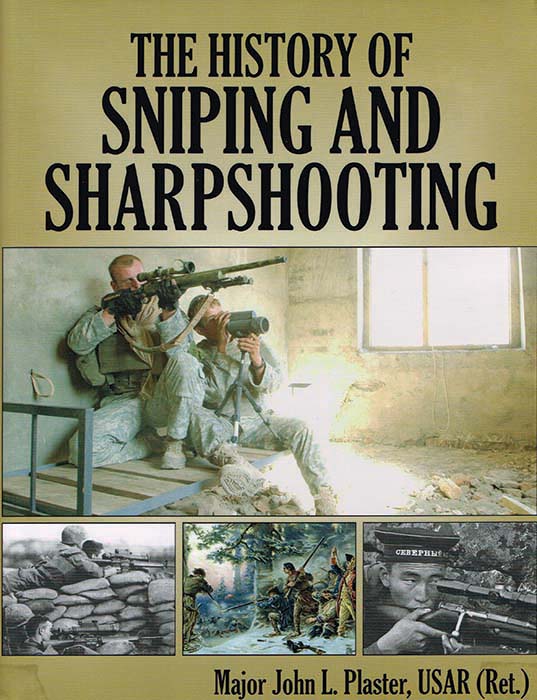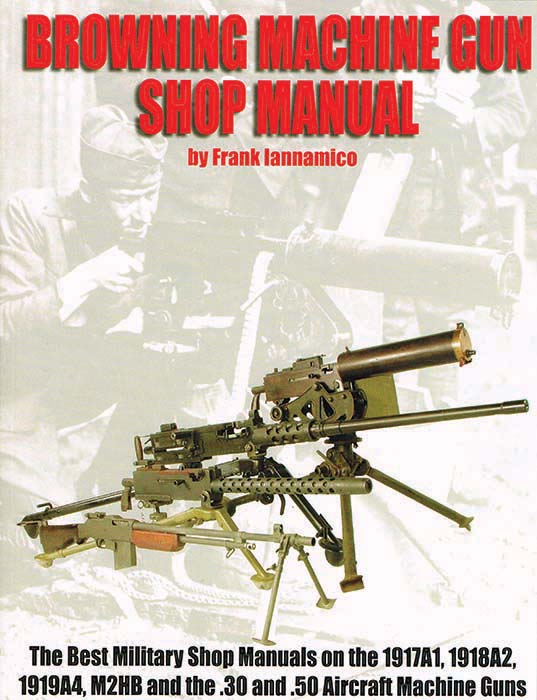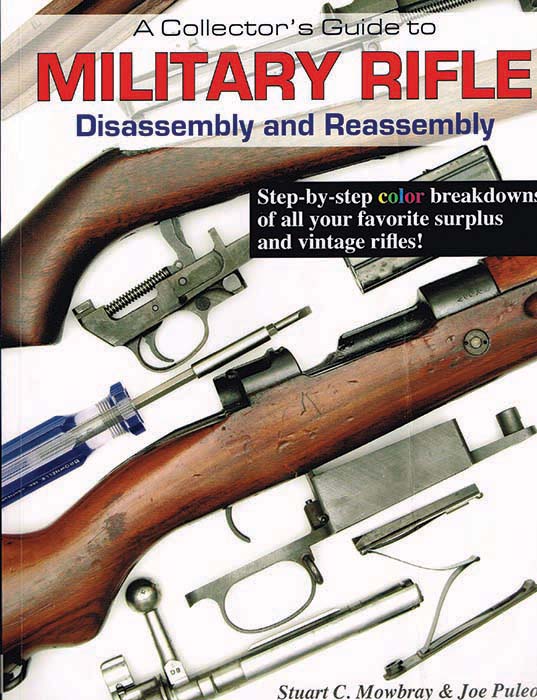By Dean Roxby

The History of Sniping and Sharpshooting
By Major John L. Plaster, USAR (Ret.)
Approx. 700 pages. Full color dust cover, hard cover.
Many B&W photos, 8.5×11 inches. $89.95
Copyright 2008, Major John L. Plaster, USAR (Ret.)
Published (2008) by
Paladin Press, Boulder
www.paladin-press.com
It was through a chance meeting with Major John Plaster that the opportunity to review this fine book arose. Major Plaster was at the huge SHOT show in Las Vegas at a vendor booth. Besides complimentary signed 8×10 photos, there were copies of his first book, The Ultimate Sniper, as well as this book, The History of Sniping and Sharpshooting for sale.
As the title suggests, this book is about military sniping throughout history, rather than a “how to shoot long distance” manual.
In the Preface, Plaster explains how this book came to be. During his time as a sniping instructor with the U.S. Army, he collected various bits of historical information on sniping to use as anecdotes in his lectures. As time went on, he began to develop a real interest in the historical aspects of military sniping. After a quarter century of collecting books, articles, news-clippings, and other bits and pieces, he found he had over 10,000 individual pieces of info, filling 16 crates in his basement. (No wonder the first person he thanks is his wife, for her unending support.)
With such an astonishing number of sources, it simply isn’t possible to list them all. Instead, Plaster chose to list only published books in the bibliography. Even still, the bibliography is huge, running 12 1/2 pages. With such extensive and thorough research, this book is an excellent reference for the history of sniping.
It is divided into six parts, and further broken into 18 chapters, arranged chronologically. The first chapter looks far back to the earliest battles using crude firearms. The first example given of a specific “high value target” is during the naval battle of Texel, on August 10, 1653, during the First Anglo-Dutch war. Dutch Navy Admiral Maarten Harpertszoon Tromp, commanding a fleet of 100 Dutch ships, was picked off by a British rifleman firing from high up in the rigging of a British vessel. The loss of Admiral Tromp contributed to the British victory at Texel.
What is particularly good about this book is the worldwide coverage Major Plaster provides. It is much more than just U.S. or European history. Battles both great and small, and individual soldiers, some famous, most long forgotten, from all corners of the world are covered in detail. From El Salvador’s One Shot War in 1885 (General Barrios of Guatemala attempted to invade neighboring El Salvador. One well-placed shot killed Barrios and ended the invasion), to the current conflicts in Iraq and Afghanistan, a huge amount of historical data is presented.
Part 4 covers the two World Wars. The World War One section ends with the tragic tale of Canadian Army Private George Price. Pvt. Price has the unfortunate distinction of being the very last soldier killed in WW1, sniped a mere two minutes before the agreed upon truce at exactly 11:00 a.m., November 11, 1918.
In Part 6, Sniping Into The 21st Century, Major Plaster describes various technical advances made since the Viet Nam war. Purpose built sniper rifles chambered in .50 BMG and .338 Lapau Magnum, scopes with Mil-Dot reticules for accurate range estimation, as well as Bullet Drop Compensators and night vision equipment are covered. Also described are separate electronic items such as laser rangefinders, wind gauges, and handheld computers. These computers have special software to correct for variables such as air density, head or tail wind, current temperature that can affect the powder burn rate, and even the Coriolis Effect, caused by the earth’s rotation.
As this book was published in 2008, it mentions Canadian Forces Cpl. Rob Furlong breaking the distance record previously held by Sgt. Carlos Hathcock in 2002. However, it does not mention the current record shot by British sniper Cpl. Craig Harrison in 2009.
As you might expect with this much information, it is a large book, at 657 pages of text, plus Preface, Bibliography, and Index (over 700 pages total). Interspersed throughout the main text are many sidebars providing additional background on specific incidents, people, places, equipment, and such.
The book is easy read, due to both the writing style, as well as the open spacing, larger font size, and the quality glossy paper. There are many hundreds of B&W photos, sketches, maps and period paintings throughout.
Perhaps some color photos could have been included, rather than entirely B&W. Naturally, period photos from WW1 and earlier could only be B&W, but recent photos of old equipment could have been done as color. The only other minor complaint is that at times Plaster seems to be listing off a long series of names of injured or killed servicemen. It seems that he has just transcribed battle reports into his text. Not a big deal really, but it is something that is worth noting. Overall, this is a fine book and recommended.

Browning Machine Gun Shop Manual
By Frank Iannamico
298 pages. Color soft cover, 8.5×11 inches, B&W line drawings throughout, $29.95
Published by Moose Lake Publishing, LLC. (2002)
www.smallarmsofteworld.com
The Base Shop Data Manuals (BSDM) are a series of weapons manuals originally created by the U.S. Rock Island Arsenal for the U.S. Ordnance Dept. during World War 2. This book is a compilation of six different ones featuring machine guns from John M. Browning. Each of the six manuals covers a separate Browning gun, specifically: M1917A1, M1918A2 BAR, 1919A4, M2HB, and both .30 caliber and .50 caliber aircraft machine guns.
Each manual is divided into sections covering Disassembly, Overhaul, and Assembly. Very clear line drawings depict the various gun parts perfectly, perhaps even more clearly than a photograph could. Certainly the exploded views show the relationship of parts with great clarity.
The Overhaul segment of each BSDM is particularly interesting, as it spells out in great detail how to service that type of gun. Many specialized tools are shown in use. In the M1919A4 chapter, there are even machinist drawings for some of the tools and tooling jigs.
This book is not a cheap photocopy job of common everyday Field Manuals. The internet has plenty of that already. Original BSDM are rare, and these versions have been digitally cleaned up and reformatted for this publication. The line drawings and text instructions are crystal clear and present no problem reading.
Whether for general interest, or to keep your BAR or BMG running in peak condition, this book is a valuable source of information.

A Collector’s Guide to MILITARY RIFLE
Disassembly and Reassembly
By Stuart C. Mowbray and Joe Puleo
304 pages, color throughout, color softcover
$39.99, plus $4.50 shipping

A Collector’s Guide to PISTOL & REVOLVER
Disassembly and Reassembly
By Stuart C. Mowbray and Joe Puleo
280 pages, color throughout, color softcover
$39.99, plus $4.50 shipping
Mowbray Publishing,
54 East School Street,
Woonsocket, RI 02895
www.gunandswordcollector.com
These two companion books are beautifully illustrated reference resources. Each book features crisp clear professional photographs of each gun, laid out step by step. Each particular firearm has an overall photo followed by many detail photos of the disassembly process. Specific details are noted with arrows and text, alerting the reader to potential issues. Reassembly hints are given in many cases as well.
There is very little background history given, but that is not really an issue, as that info can be found easily elsewhere. These books focus exclusively on the proper disassembly steps.
The Military Rifle book (published 2007) was the first of the two published. Immediately upon release, the authors were bombarded by requests for a Pistol and Revolver book. They freely admit that they did not originally plan to do so, but quickly got to work on the second book (published 2011).
The two authors are staff writers for the NRA collector magazine publication Gun Collector, with Mowbray being the editor and Puleo being a contributing technical editor. As such, they have a large body of experience and knowledge to draw from.
Both books are laid out in roughly chronological order, starting with the oldest designs first. The rifle book begins with the French M1866 Chassepot, and concludes with the Egyptian Rasheed, with a total of 44 rifles featured. The pistol book begins with the Colt Model 1873 SA Army revolver and wraps up with the Czechoslovakian CZ-82, with a total of 51 guns featured.
Both are a full 8.5” x 11” and printed on high quality glossy paper. Both are soft cover. The rifle book is 304 pages, and contains over 1,500 color photographs. The pistol book is 280 pages, and contains over 1,200 color photos.
Obviously, not every military rifle or handgun can be featured, and the authors acknowledge as much. Aside from that, I found these books to be very well done. They should appeal to collectors, re-enactors, students of history, and fans of beautiful books.
| This article first appeared in Small Arms Review V18N3 (June 2014) |











